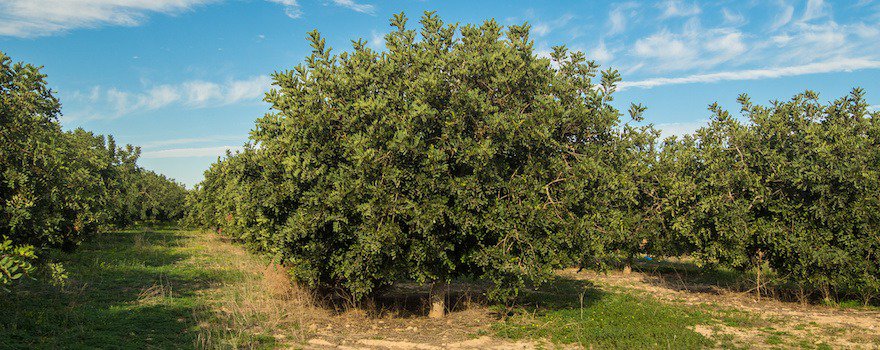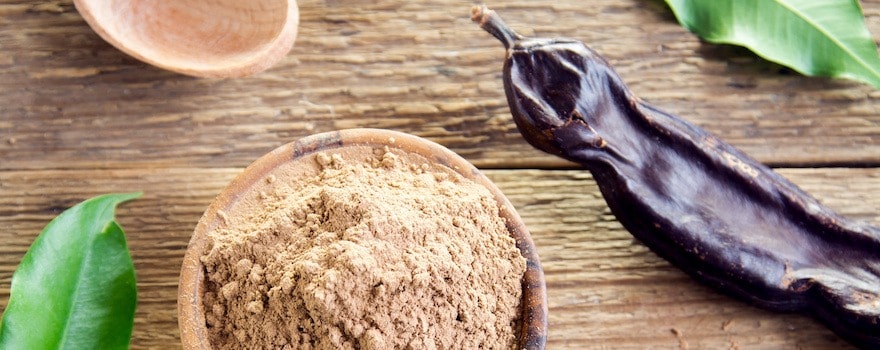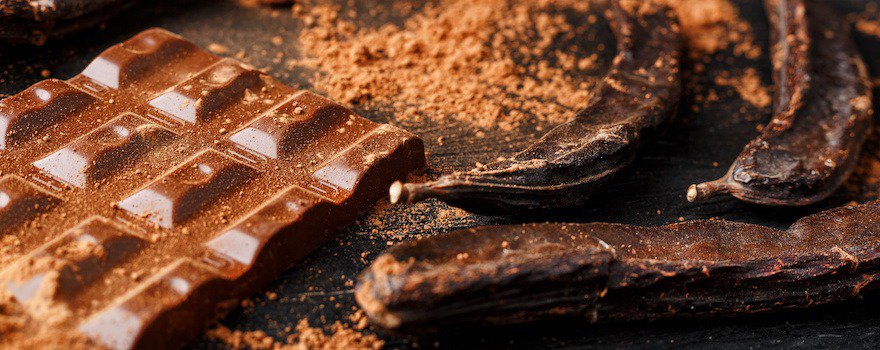The benefits of carob flour
What is carob flour?
Carob flour is obtained by grinding the pods of the carob tree (Ceratonia siliqua). Native to the Mediterranean regions, this tree belongs to the large legume family. Once the flowers fade, green pods 10 to 30 cm long appear: these fruits are called “carobs”.
Over the months, carobs gradually change from green to brown. When they reach maturity, they are harvested by hand and used in various ways. The seeds can be extracted and ground to produce carob seed flour or carob gum. But it is also possible to grind only the fruit’s husk to obtain carob flour or powder, the ingredient we are interested in today.

An ultra-nutritious flour
Carob flour is a particularly nutritious superfood. Fiber, proteins, vitamins, antioxidants, minerals, trace elements… it is full of beneficial nutrients for health and helps better meet the recommended daily needs.
In terms of fiber, carob flour is a champion! With 40 g of fiber per 100 g, it ranks well ahead of wheat bran (25 g per 100 g), chicory (29 g per 100 g), or cocoa (33 g per 100 g).
Consuming carob flour is ideal for relieving all the little inconvenience of transit, especially constipation or diarrhea. It acts as a natural laxative for better intestinal and digestive comfort.
Its richness in vitamins is another major advantage of carob flour. It is particularly rich in vitamin A and vitamin E. Vitamin A, or retinol, is involved in cell renewal, maintaining skin and eye health, and the functioning of the immune system. As for vitamin E, it is antioxidant and anti-inflammatory. Carob flour also contains vitamins B2, E, and D2.
Finally, to complete its already rich composition, it should be noted that it contains minerals and trace elements such as iron, potassium, and calcium. A real cocktail of nutrients that are good for health and our daily well-being!
A slimming ally
Thanks to its high soluble fiber content, carob flour is very interesting for accompanying weight loss. Indeed, fibers are natural components that, once in the stomach, take on a gelatinous texture. This “gel” is a transit regulator that absorbs water and promotes the feeling of fullness.
Thus, like chia seeds or psyllium, carob flour is an excellent natural appetite suppressant that will help you limit snacking between meals.
This flour also has the advantage of preventing potential deficiencies caused by a diet or changes in eating habits.

How to choose your carob flour?
Carob flour or carob seed flour?
Be careful not to confuse carob flour with carob seed flour.
- The first is from grinding the pod. It therefore contains the husk and the sweet, yellow pulp of the carob.
- Carob seed flour, on the other hand, is obtained by grinding only the seeds contained in the pod. You can also find it under the name “carob gum“.
Carob flour and carob seed flour do not have the same properties or uses in cooking.
Quality criteria
If you are looking for carob flour, you will find that there is a wide range of products. However, all flours are not equal and there are significant differences in quality.
We advise you to choose carob flour that is certified organic to avoid pesticide and chemical residues.
Also prefer flour from fair trade to support the work of local farmers. Today, many farmers live from carob cultivation, such as in Spain, Morocco, Italy, or Portugal, the 4th largest producer worldwide.

How to cook with carob flour?
Carob flour and coconut cake
The sweet flavor of carob flour blends wonderfully with coconut. It is thus possible to make a delicious light-textured cake that will delight the taste buds of both young and old.
To make this recipe, you will need:
- carob flour
- grated coconut
- eggs
- butter
- plant-based milk
- cane sugar
- wholemeal flour
- cocoa powder
- baking powder.
For a lower-calorie cake, you can replace butter with applesauce or hazelnut oil.
- Start the preparation like any other cake recipe, with the dry ingredients. First, mix the carob flour with the cocoa powder, wholemeal flour, and baking powder.
- In another bowl, vigorously whisk the eggs and sugar. Then pour the “flours/cocoa/baking powder” mixture into the beaten eggs.
- Place the butter in a saucepan and melt it over low heat. Add the milk and melted butter to the previous mixture. Mix well using a wooden spoon until you obtain a homogeneous batter. Finally, add a few pinches of grated coconut.
- For baking, pour your cake batter into a pre-oiled mold and bake for 30 minutes at 180°C. To finish the presentation, you can sprinkle your cake with grated coconut or raw cocoa flakes.
Chocolatey milkshake… without chocolate!
Carob flour has a delicious chocolatey flavor. This is why it is often used as a substitute for chocolate in sweet preparations.
To make your carob flour milkshake, simply blend 1 tablespoon of flour with 2 glasses of plant-based milk of your choice. To bind and thicken your drink, add 1 to 2 bananas depending on the desired texture. Blend everything one last time: your milkshake is ready!

Raw carob, cocoa, and mandarin mousse
This recipe will delight all raw food enthusiasts! A raw mousse that combines the sweetness of carob flour and cocoa with the freshness of mandarin.
The ingredients to prepare this recipe are as follows:
- 60 g of raw cocoa
- 60 g of carob flour
- 125 ml of coconut milk
- 1 tablespoon of honey or, why not, carob syrup
- Mandarin essential oil
To begin, mix the carob flour with the coconut milk in a blender. Then add the tablespoon of honey or carob syrup and a few drops of mandarin essential oil. Blend everything until you get a smooth and creamy mousse. Finally, pour your preparation into small verrines.
Let your raw mousses cool in the refrigerator for at least 4 hours. When ready to serve, crumble hazelnuts on top or place a few goji berries, slightly sweet and tangy.



